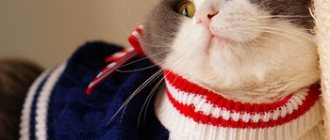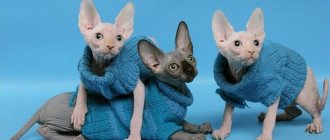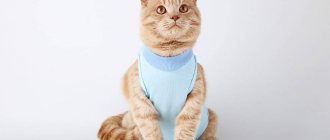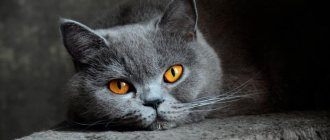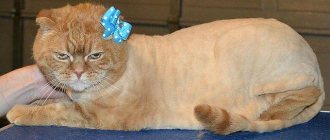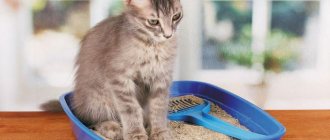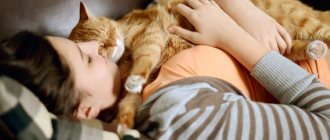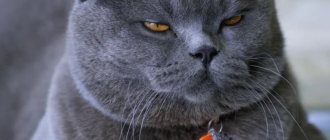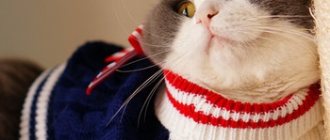How to measure a cat correctly and choose a model according to the measurements.
You have decided to dress your cat. Of course, the pet store is full of stuff. But it is mainly for dogs, and is not very suitable for cats due to the difference in anatomy. I am helping to solve this problem by making clothes tailored specifically to the needs of cats. In my store you can choose from ready-made models or order custom-made clothes, in both cases you will need to measure the animal. I’ll tell you and me about how to do this correctly, and how to place an order so that everything is as quickly and convenient as possible.
- Let's measure!
In order for the measurements to be correct, it is necessary for the cat to stand on all 4 paws during the measurement process, and not to huddle, shrunken, with its paws pulled under its belly! So, it’s convenient to measure together with an assistant after catching the cat in a good mood. If a cat is afraid of a centimeter (and this happens!), you can measure it with any string and then transfer the measure to a centimeter and write down its value. For most things you don't need a lot of measurements.
Length of the cat (1) and its chest circumference just behind the front paws (2)
J are also found . Then you will need the volume of the belly at the widest point. (For cats with a decent belly, everything is sewn individually ONLY! Ready-made models are mostly based on standard cats!) If the cat has a very thick neck, it’s worth trying it on too! At the base where the collar cutout will be.
To avoid mistakes, it is advisable to repeat the measurement 2 times.
Selecting the right size from a ready-made one.
To choose from ready-made ones according to these standards, look at the dimensions written under the finished model.
The volume behind the front legs is measurement 2 ! If the cat is an adult - We look at a model that is not the same volume as you have measured (it will completely fit on the cat) and a model for a couple - three centimeters wider (but NOT more, otherwise the cat will fall out of it and it will not be comfortable for her!).
Clothes for cats - necessity or whim?
Even the ancient Egyptians used clothing for cats. It was in Egypt that cats were especially revered and valued. They were given precious stones, delicious food and expensive clothes as gifts. Despite the fact that the deification of cats remains in the distant past, some features of their maintenance have survived to this day.
It is necessary to dress pets not only for the sake of beauty or the whim of the owner, but also to protect the body from hypothermia, overheating, precipitation and drafts. Of course, not all four-legged friends will need items of clothing: some breeds have a thick coat and thick undercoat, so they do not need insulation. The same cannot be said about Sphynxes and smooth-haired cats; they need protection from the harsh Russian winters.
Also included in the vulnerable category are kittens, old pets and animals that have undergone surgical operations with extensive clipping of areas of fur.
In any case, a blanket is put on your four-legged friend after surgery to prevent the animal from licking or scratching the wound. In this case, the medical bandage also protects the cat from cold and drafts.
Sphinxes are dressed not only in winter, but also in summer. To protect pets from the scorching sun, cotton T-shirts are used. If this is not done, the skin of Sphynxes and Levkoys will become dry and covered with spots.
Clothing saves cats that are accustomed to walking outside not only from precipitation, but also from fur contamination and parasites. In the latter case, there is no 100% guarantee of protection, but protective overalls significantly reduce the risk of disease. To protect a cat from accidental relationships with other animals, you can also put a protective suit on it, and then the owner will not have to solve the problem with kittens.
Some owners dress up their pets in beautiful holiday outfits, which in everyday life are not entirely comfortable for constant wear. As a rule, this is done for participation in exhibitions and photo shoots.
Why do you need to determine the age of a kitten?
It is advisable to know the age of your pet, especially when it is picked up on the street. At least in order to get vaccinated in a timely manner or treat him with those drugs that are permissible and acceptable for him.
Animals that are younger than four to five months cannot be transported across the country’s border. Although this is due to the fact that after mandatory vaccinations against viral infections and rabies, a quarantine period of at least 30 days must pass.
Therefore, if a foreign breeder tries to sell a baby and claims that he is five months old, but he looks like three, you should doubt it and figure it out.
You can also come across scammers who sell small-sized adult animals under the guise of a purebred kitten in Russia. In this case, advice on how to determine the age of a kitten will definitely come in handy.
Materials and requirements
The main materials in the manufacture of clothing for cats are:
- cotton and linen fabrics, calico - ideal for sewing summer clothes. Thanks to excellent thermoregulation, the animal feels good, even on the hottest summer day. The only negative is that after washing the clothes shrink and become very wrinkled;
- synthetic materials are ideal for sewing elegant holiday costumes. This type of material is not used for everyday wear due to low air permeability;
- wool, knitwear - for winter clothing options. For example, mohair has high breathability and provides excellent warmth and does not cause allergies in pets.
The material of things intended for walking is combined - for example, water-repellent fabrics are combined with padding polyester filling. These fabrics are easy to wash, dry quickly and practically do not wrinkle. The top layer of clothing (especially for spring and autumn) is made of bolognese fabric or raincoat. It perfectly repels moisture and protects the animal's fur from dirt.
For everyday clothing, it is necessary to select lightweight fabrics that will not hinder the animal’s movements. If the material of the costume clings or causes any discomfort, the pet may be injured during active games.
Home clothes for daily use must meet the following requirements:
- easy to wash;
- fabrics must be durable and light. During wearing, cats often cling to clothes with their claws, and in order not to tear the outfit, the material must be strong enough;
- a minimum of accessories (i.e., exclude the presence of an excessive number of rivets, buttons, zippers, fasteners and ruffles);
- seams and fasteners must be hidden. Buttons should not be sewn on at all; the animal can tear them off and swallow them.
Favorite pets: what will they be like in 5 years?
Any cat breed is characterized by individual characteristics that are manifested in appearance and character. One of the signs is the size and shape of the animal’s body. Some breeds of domestic cats grow to large sizes. But fluffies have also been bred, which remain medium and small. The average body length of a cat is 54 cm (and sometimes all 60), the tail length is 20-30 cm. Animals usually grow up to 14 months, but in the largest breeds an increase in weight can be observed even after 2 years of age.
The length of the cat and its size within, for example, a 1-room apartment plays a role for future owners. When choosing a furry four-legged friend, the family first of all considers what normal size it will grow to in 5 years.
Large breeds
Big cats
Cats that are medium size
Little cats
This species is represented by the Oriental breed. Characteristic features are a long slender body and skeleton, developed muscles, huge ears, and a thin tail. It is considered the most sophisticated of all breeds. Similar to the Siamese, only the coloring lacks the dark pattern on the coat. About 17 colors are possible, the exotic ones being black (ebony) and chocolate (Havana).
The Russian Blue is a luxurious domestic cat with deep green eyes. Almond-shaped eyes, long straight neck, high legs, rounded paws. Sociable and unpretentious, with an exceptionally pliable character and flexible temperament. Because they love freedom, they are suitable for any conditions.
Source
Cat outfits
Manufacturers of pet products, in addition to food, vitamins and other paraphernalia, also offer a wide selection of outfits. For example:
- Overalls, jackets and raincoats are protective clothing for your four-legged friend from cold, rainy and dirty weather.
- T-shirt, shirt - suitable for use at home or in warmer months. This type of clothing protects your pet from excessive overheating and harmful parasites (ticks, mosquitoes and fleas);
- A blanket and vest are an indispensable outfit for walks or during the postoperative period;
- Bathrobe - put on the pet after a bath and water procedures;
- Protective body – prevents accidental mating of a cat with a male;
- Original suits and dresses – for exhibitions and photo sessions;
- Hats and boots - used either in cold, dirty weather, or for exhibitions and photo shoots.
Age verification
First of all, you should ask the pet’s age at the nursery or at the seller if the baby is not found on the street.
The breeder will be able to tell you the exact date of birth; in addition, the animal must have a veterinary passport, birth certificate or certificate of birth of the litter.
The age of kittens from a shelter is most often determined with certain accuracy by veterinarians and felinologists working there.
If you want to know the exact age of the kitten, you can contact a veterinary clinic that has a good reputation and experienced specialists. By comparing all of the above signs, you can approximately determine how many weeks, months or years old the pet is.
How to determine the size of a product?
Each pet has its own structural features and body size. When choosing clothes, you should focus not only on the physical parameters of the animal; many nuances depend on the breed and age of the pet.
How to determine the correct size? Take a tape measure and measure your furry friend. Required measurements:
- neck circumference - measure at the widest point;
- chest circumference (measure under the front legs);
- length along the back from the withers to the base of the tail;
- head circumference (for hats).
Cat clothing sizes are classified depending on the back length:
- 30 cm (XXS);
- 33 cm (XS);
- 35 cm (S);
- 37 cm (M);
- 40 cm (L);
- 45 cm (XL);
The clothes purchased should be durable, comfortable and practical. After washing, high-quality items do not shrink, stretch or wrinkle too much. When choosing clothes for your pet, consider the time of year: in winter, warm clothes are the best option, and for the autumn-spring period, microfiber and raincoat fabric are suitable. In summer, it is best to buy breathable outfits.
Definition of puberty
When a pet comes into a person’s house at an unknown age and it was not possible to calculate it based on its teeth, size and weight, it is enough to wait for the first signs of puberty.
In almost all breeds, females are ready for fertilization by ten to twelve months, and the first heat can occur between six and eight months.
A male can feel the first signs of rutting at about the same age, but some cats remain indifferent to the opposite sex for up to a year or a year and a half.
Both male and female cats can begin to actively mark their territory during puberty.
Typically, purebred kittens reach sexual maturity later than their domestic counterparts.
But the first signs of approaching maturity can be noticed in a pet from four to five months, as hormonal changes in the body begin. This manifests itself in active sniffing of an animal of the opposite sex, and signs of some irritability and aggression appear.
Males can start fighting, dividing territory and females as early as six months. Therefore, you need to behave especially carefully with such teenagers.
How to find out a cat's breed by coat color
Aristocratic cats compare favorably with ordinary yard cats by their variety of colors . For the latter, it is often simple - tricolor, spotted and striped, one- and two-color.
Breeders worked on the color of purebred cats, achieving interesting colors.
Siamese
The Siamese color or color point is one of the most beautiful and spectacular . It is characterized by dark areas on the animal's face, paws, ears and tail. The body is light in color.
Initially, only Thai and Siamese cats had this color, but as a result of breeding work, the following breeds acquired the Siamese color :
- Balinese;
- Burma;
- Himalayan;
- Neva Masquerade;
- Persian;
- ragdoll;
- snowshoe.
There are several variants of point colors:
- blue point - silver-blue;
- caramel point - gray-beige;
- cream point - beige-amber;
- lilac point - pink-blue;
- red point - rich apricot;
- seal point - delicate cream;
- fan point - pale cream;
- cinnamon point - reddish brown;
- chocolate point - brown chocolate.
Only a specialist can identify point colors . Kittens are born white and the markings appear after a few days.
Blue
The blue color is the same as solid gray, an integral characteristic of the British Shorthair cat . The color is determined immediately at the birth of the babies.
Shades of gray are found in these breeds:
- korat;
- Maine Coon;
- Nibelung;
- oriental;
- Russian blue;
- chartreuse;
- Scottish.
Sand
Sand color or sorel is the least common color and defines the breeds - Abyssinian and Somali cats . The fur is unevenly colored: the main part is bright red (copper), and the tip is ticked (dark, chocolate brown).
Abyssinian cat
Wild
Wild natural color or tabby is characterized by the presence of clear spots, stripes, rosettes , making domestic cats small copies of leopards and cheetahs. This color is observed in the Bengal, Egyptian Mau, Siberian cat, Asherah, Safari, Serengeti, Kurilian bobtail, Ocicat, Caracat, Kanaani. The color is characteristic of hybrid breeds and is determined instantly.
Mackerel tabby color
Brown
Brown or chocolate uniform, monochromatic coat color is typical for cats of royal origin and is almost never found in the wild.
The breeds can boast of this color:
- Abyssinian;
- British;
- Burmese;
- Havana Brown;
- Persian;
- Chantilly Tiffany;
- Scottish.
How to recognize a cat's breed by its special coat
The structure of the coat varies greatly among different breeds . Cats are mostly divided into short-haired and long-haired.
Long, thick and straight coat with dense undercoat:
- Angoras;
- Burmese;
- British and Scottish longhair;
- Himalayan;
- Maine Coon;
- Neva Masquerade;
- Norwegian forest;
- Persian;
- ragdoll;
- Siberian;
- Somalia;
- Turkish van.
How to recognize a cat's breed by external differences
Studying the appearance features will help determine the cat's breed .
The shape of the ears is a striking distinctive feature indicating belonging to a particular breed.:
- forward-curved ears are characteristic of the Scottish Fold and Highland Fold;
- turned back - only in the American Curl;
- small, low-set, close to the head - in the Highland Fold;
- medium-sized ears, devoid of vegetation with drooping tips - in the Ukrainian Levkoy;
- large, wide at the base, open, with smoothly curving tips - in the elf;
- triangular, pointed, with tassels at the tips - in the Maine Coon;
- hanging ears covered with curls of hair - the poodlecat;
- disproportionately large in relation to the head - in Abyssinians and Orientals.
Short tail
A short tail is a congenital trait that defines the breed:
- American and Kurilian bobtail;
- pixie bob;
- toy bob;
- Kymrik.
Toy Bob Tailless breeds - Japanese Bobtail and Manx cat.
Reference. Cats of the eastern group of breeds have long and thin tails.
Little paws
In nature, short-legged cats are rare.
All breeds with short limbs were bred artificially:
